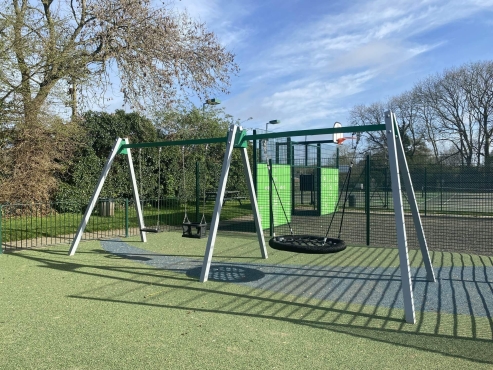
Apr

How Swings Support Child Development: From Balance to Brain Growth
Swings are more than just a nostalgic staple of childhood—they’re powerful tools for child development. At first glance, the simple back-and-forth motion may seem like pure fun. However, the act of swinging supports a wide range of developmental benefits that touch on everything from balance and coordination to brain growth and sensory integration.
In this guide, we explore how swings contribute to the holistic development of children and why they should be an essential feature in every playground.
The Physical Benefits of Swings
Balance and Coordination
Swings play a crucial role in developing a child’s vestibular system, which is responsible for balance and spatial orientation. As children pump their legs and shift their body weight to swing higher, they develop a sense of control over their body’s movement in space. This enhances coordination and lays the groundwork for future physical activities like running, cycling, and climbing.
Muscle Development and Strength
Swinging engages several muscle groups at once. The arms grip the chains, the core stabilises the body, and the legs push off to gain momentum. This full-body workout helps build muscle tone and strength, especially in younger children who are still developing their motor skills. Regular play on swings contributes to improved posture, physical endurance, and overall fitness.
Gross Motor Skill Development
Gross motor skills involve the large muscles of the body and are crucial for everyday functions. Swinging improves these skills by encouraging children to use coordinated movements involving their limbs and torso. The act of swinging back and forth also enhances spatial awareness and helps children understand motion, distance, and body positioning.
Cognitive and Brain Development
Sensory Integration
Swinging stimulates both the vestibular (balance) and proprioceptive (body awareness) systems. This type of sensory input helps children process information about their body in relation to its environment. Sensory integration is especially important for children with sensory processing difficulties, as it supports better focus, coordination, and emotional regulation.
Focus and Brain Stimulation
The rhythmic motion of swinging is soothing and can enhance a child’s ability to concentrate. Studies have shown that activities involving repetitive motion can activate areas of the brain responsible for learning and memory. The swinging motion provides predictable sensory input, which can help calm an overstimulated nervous system and improve attention span.
Risk Assessment and Problem Solving
Learning how to use a swing independently requires trial and error. Children must assess how to balance, when to kick their legs, and how to slow down safely. These experiences promote problem-solving skills and help children develop risk assessment abilities in a controlled, safe environment.
Emotional and Social Benefits
Confidence and Independence
Mastering the ability to swing on their own is a milestone for many children. This sense of achievement boosts confidence and fosters independence. Over time, children learn to challenge themselves—swinging higher, jumping off (safely), or trying different types of swings—each accomplishment reinforcing self-esteem.
Sharing and Turn-Taking
In playground settings, swings are often in high demand. This creates opportunities for children to learn about sharing, patience, and turn-taking. These are essential social skills that help children navigate group settings, both in school and beyond.
Calming and Therapeutic Effects
Swinging has a naturally calming effect on the nervous system. For children with autism, ADHD, or anxiety, swings can provide a form of sensory therapy. The predictable, rhythmic motion helps soothe overstimulation and can be used as part of a sensory diet to support emotional regulation and behavioural control.
Different Types of Swings and Their Unique Benefits
Not all swings are created equal. Different types of swings offer distinct developmental benefits, making it important to include a variety in any well-designed playground.
Basket Swings: Also known as nest swings, these can be used individually or with multiple children. They encourage cooperative play and social interaction, and their gentle movement is particularly beneficial for children with sensory sensitivities.
Rope Swings: These enhance grip strength and require more balance and coordination, supporting physical development.
Tandem Swings: Allow two children to swing together, promoting teamwork, communication, and shared enjoyment.
Wheelchair-Accessible Swings: Designed to accommodate mobility devices, these swings ensure that children of all abilities can enjoy the benefits of swinging.
Traditional Flat or Belt Swings: Great for older children developing independence and strength through active pumping.
Why Swings Belong in Every Playground
Swings provide a rare combination of physical, cognitive, emotional, and social benefits. Whether it’s helping toddlers gain their first sense of balance or providing older children with an outlet for focus and relaxation, swings serve all age groups and developmental stages.
At Caloo, we understand the importance of designing play equipment that supports child development while ensuring safety, inclusivity, and fun. Our extensive range of swing units includes:
• Toddler swings with high backs and safety harnesses
• Inclusive swings with full-body support and wheelchair accessibility
• Traditional swings for all-round physical and sensory development
By incorporating various swing types into a playground, local authorities, schools, and community developers can cater to a diverse group of users, making play more inclusive and beneficial for everyone.
Swings for Different Age Groups
Swings can be tailored to suit different developmental stages, providing age-appropriate support and safety features.
Infants and Toddlers (6 months–3 years): Bucket or cradle swings with safety harnesses provide support while introducing babies to gentle motion.
Preschoolers (3–5 years): Low-height swings with soft seats help children build confidence while refining motor coordination.
Primary School Children (5–12 years): Standard belt swings and more dynamic designs like rope swings offer increased physical challenges and opportunities for independence.
Teens and Beyond: Larger swing sets and group swings can appeal to older children and teens, supporting social interaction and stress relief.
The Role of Swings in Inclusive Playgrounds
Inclusive playgrounds are designed to be used by all children, regardless of ability. Swings are a key component of this approach.
Inclusive swing options such as full-support swings, high-backed swings, and wheelchair-accessible platforms allow children with physical disabilities to participate fully. For those with cognitive or sensory impairments, swings offer predictable movement that can be calming and therapeutic.
When inclusive swings are integrated into playgrounds, all children benefit. Neurotypical children learn empathy and inclusion, while children with additional needs experience equitable play. This fosters social cohesion and creates a more welcoming, diverse community environment.
Statistics on Play and Development
Evidence consistently supports the developmental importance of play. Here are some compelling statistics:
• According to the NHS, children aged 5 to 18 should engage in at least 60 minutes of some form of physical activity each day. Playgrounds, and particularly swings, offer an enjoyable way to meet this goal.
• A study by the American Academy of Paediatrics found that play enhances brain structure and function, promoting better memory, focus, and academic performance.
• Research from the University of Loughborough revealed that outdoor play improves mood, reduces anxiety, and supports emotional resilience.
• Inclusive playgrounds have been shown to boost social interaction by up to 40% between children with and without disabilities, according to research from Scope UK.
The Lasting Impact of Swings on Child Development
Swings are much more than playground favourites—they are essential tools in fostering physical, mental, and emotional development in children. From improving muscle coordination and balance to enhancing focus, sensory processing, and confidence, the benefits are both immediate and long-lasting.
At Caloo, our mission is to support healthy childhood development through safe, innovative, and inclusive playground equipment. If you’re planning a new playground or upgrading an existing one, explore our wide range of swing units designed to meet the needs of every child.
Ready to enhance your play area with high-quality swings? Contact Caloo today and let us help you build a playground that truly supports child development.

















